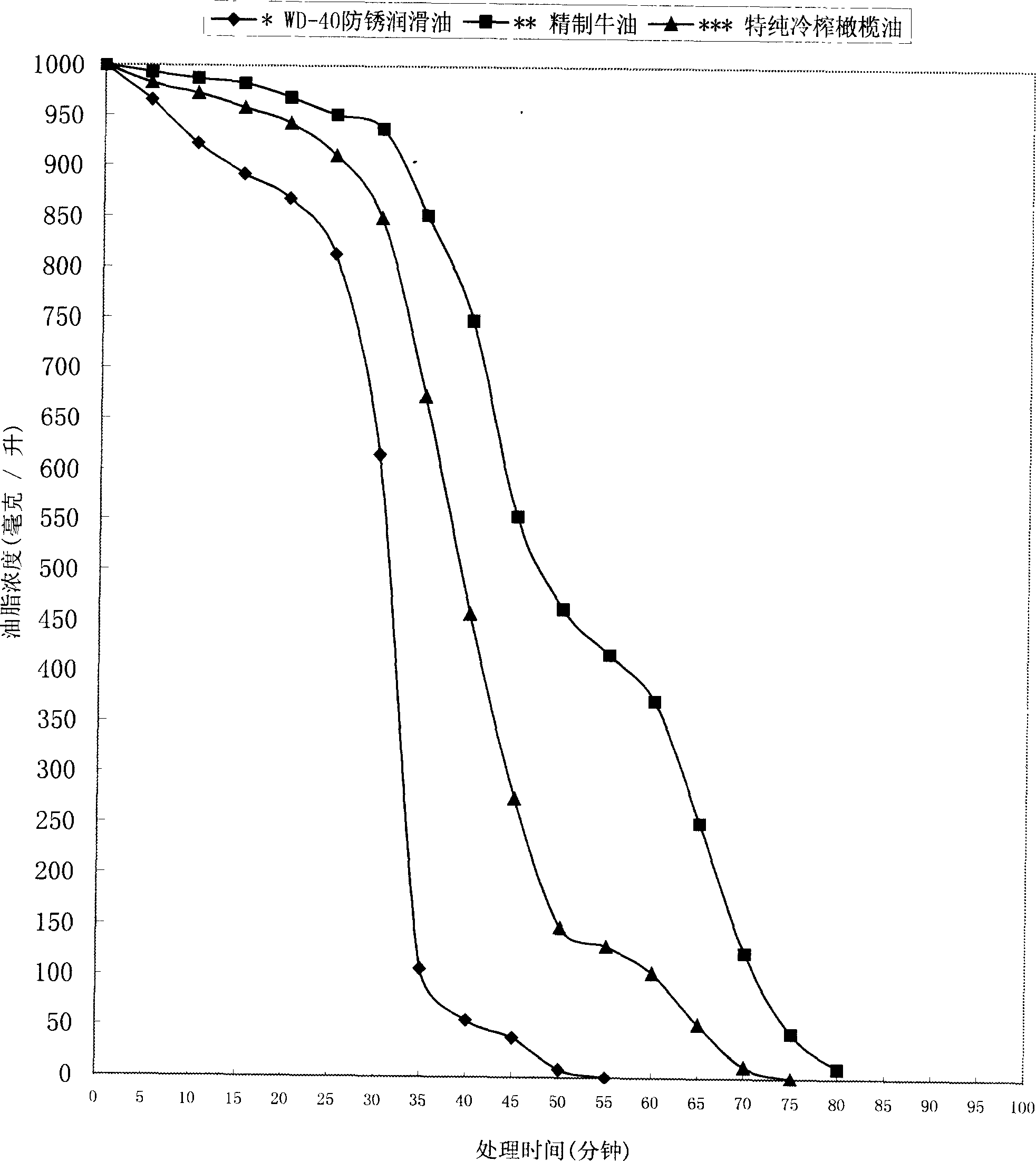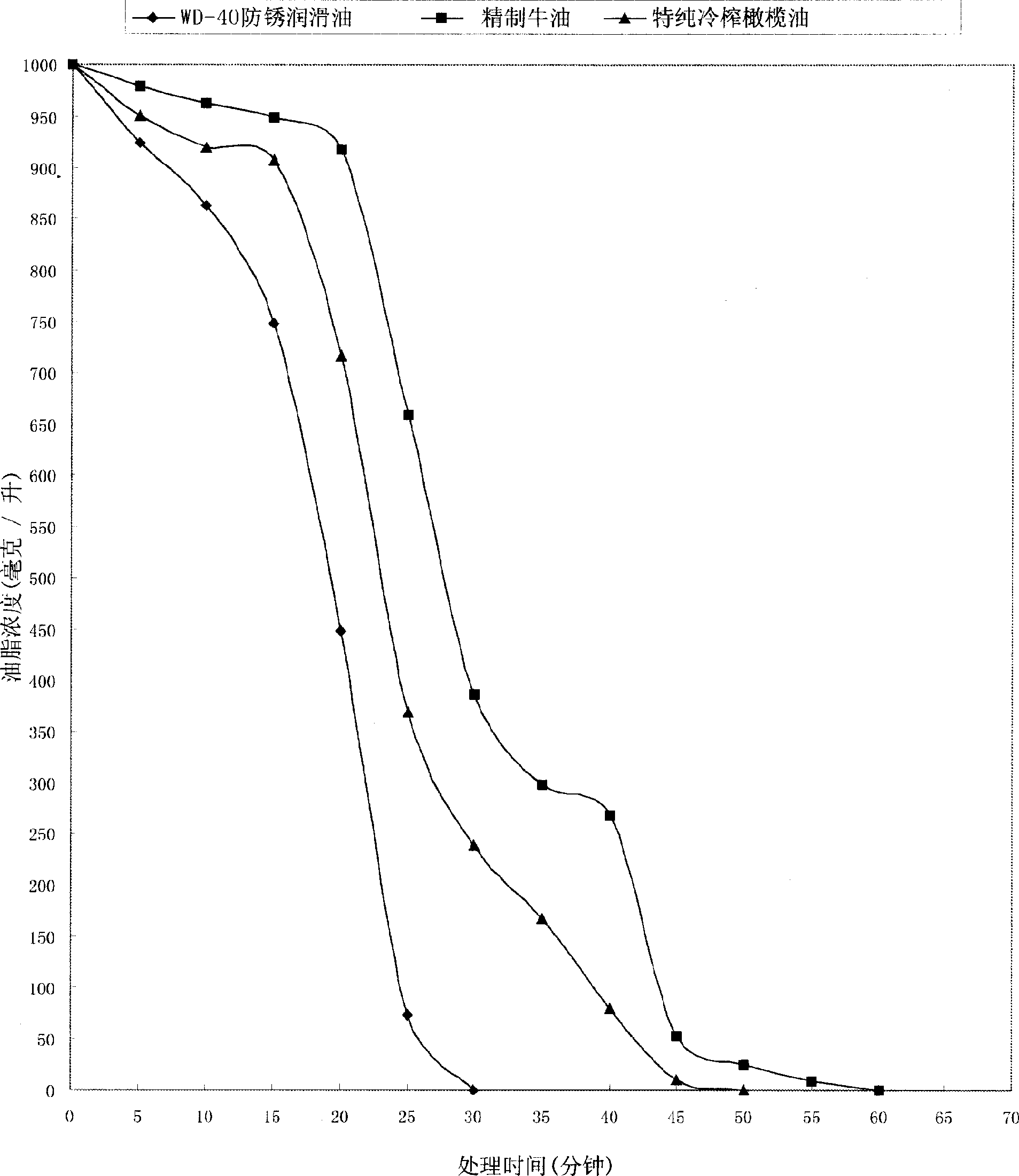Biological degreasing agent used in metal processing pretreatment of oil removing and degreasing, and method for processing metal surface greasy dirt
A technology of metal surface and degreaser, which is applied in the field of biological degreaser, can solve the problem of non-decomposed oil pollution, and achieve the effect of reducing process steps
- Summary
- Abstract
- Description
- Claims
- Application Information
AI Technical Summary
Problems solved by technology
Method used
Image
Examples
Embodiment 1
[0033] The biological degreasing agent in the present embodiment is made up of main agent, and its proportioning is as follows:
[0034] Phosphatidylglycerol 4.00%, alkyl glycoside 11.00%, alkyl ether carboxylate 7.00%, Bacillus subtilis, Bacillus polymyxa and Xanthophylla 6.00%, water 72.00%.
[0035] 1. According to this ratio, mix evenly in a test tank with a volume of 3 liters, and prepare 2 liters of main ingredients.
[0036] 2. Add 2 liters of 90# gasoline to another experimental tank with the same volume.
[0037] 3. The experimental oil used in this experiment is Purelube SAE 30 Non-detergent Oil (manufactured by HAJ Inc.).
[0038] 4. In this experiment, whether 80% of the experimental oil on the Hastelloy sheet can be removed within 5 minutes is used as a sign to measure whether the degreaser has good oil removal ability: within 5 minutes, if the experimental oil removed from the Hastelloy sheet More than 80%, the degreaser is defined as having good degreasing ...
Embodiment 2
[0049] The biological degreasing agent in the present embodiment is made up of main agent, and its proportioning is as follows:
[0050] Phosphatidylglycerol 9.00%, alkyl glycoside 15.00%, alkyl ether carboxylate 20.00%, Bacillus licheniformis, Bacillus megaterium and Xanthobacter 4.00%, potassium chloride 0.3%, sodium sulfate 0.2%, water 51.50%.
[0051] 1. Based on the formulations in Example 1 and Example 2, respectively prepare 20 liters of main ingredients. Then store in a 20-liter airtight container in a cool, dry place.
[0052] 2. The experimental oil used in this experiment is Purelube SAE 30 Non-detergent Oil (manufactured by HAJ Inc.).
[0053] 3. On the day when the main ingredient is prepared, dilute the main ingredient with water at a ratio of 1:20. Then use exactly the same degreasing ability test method in embodiment 1, test the degreasing ability of two formulas respectively, test continuously for 7 days.
[0054] 4. After storage for 2 weeks, 4 weeks an...
Embodiment 3
[0063] The biological degreasing agent in the present embodiment is made up of main agent, and its proportioning is as follows:
[0064] Main ingredients: rhamnolipid 10.00%, polyoxyethylene ether 15.00%, Bacillus subtilis 5.00%, sodium sulfate 0.10%, sodium chloride 0.40%, lipase 0.20%, water 69.30%; in the degreasing tank, mix well .
[0065] 1. Degreasing test: The following is a comparison of the degreasing speed of the biological degreasing agent formula for different oils stripped from the standard Hastelloy sheet under static and dynamic conditions.
[0066] 2. The specific experimental steps of the static test are as follows:
[0067] (1) Take 2 liters of the main agent, dilute it with water at a ratio of 1:30 in the experimental tank, and prepare 60 liters of working solution.
[0068] (2) Add 10 grams of auxiliary agent to the diluted main agent, and stir evenly to prepare a biological degreasing agent.
[0069] (3) Take 15 Hastelloy tablets of standard specificat...
PUM
 Login to View More
Login to View More Abstract
Description
Claims
Application Information
 Login to View More
Login to View More - R&D
- Intellectual Property
- Life Sciences
- Materials
- Tech Scout
- Unparalleled Data Quality
- Higher Quality Content
- 60% Fewer Hallucinations
Browse by: Latest US Patents, China's latest patents, Technical Efficacy Thesaurus, Application Domain, Technology Topic, Popular Technical Reports.
© 2025 PatSnap. All rights reserved.Legal|Privacy policy|Modern Slavery Act Transparency Statement|Sitemap|About US| Contact US: help@patsnap.com


